

In today’s fast-paced world, maintaining peak productivity can be challenging. Energy levels can wane as the hours go by, and our focus can drift. In turn, this can lead to decreased productivity, errors, and even burnout.
What is one way to reduce midday fatigue and increase productivity? Take a power nap.
The power nap lasts between 10 and 30 minutes and improves alertness and productivity throughout the day. Instead of prolonged naps or sleeping at night, power naps deliver the benefits of sleep without the grogginess associated with longer periods of rest. It’s important not to fall into deep sleep, which can leave you groggy and tired.
If you think that this is hogwash, many successful people were nappers. I’m talking about Aristotle, Da Vinci, Frank Lloyd Wright, Albert Einstein, Eleanor Roosevelt, JFK, Stephen King, and Mark Cuban.
Now that we have that out of the way, let’s examine the benefits of power napping and how to do it properly.
The Benefits of Power Napping
When you’re dragging after a bad night’s sleep, daytime naps might help. A power nap is also beneficial for those who aren’t sleep-deprived. “Power naps can help you refill your tank a bit,” says sleep apnea specialist Samuel Gurevich, MD.
Taking a short afternoon nap can help you feel less sleepy and improve your:
- Reduced fatigue and increased alertness. Taking a short nap can improve alertness and reduce fatigue — especially if you’re dragging in the afternoon. According to research on pilots, 26-minute “NASA” naps improved alertness by 54% and performance by 34%.
- Improved cognitive performance. The power nap has been shown to improve cognitive performance, such as attention and memory. In studies, napping improves creativity, vigilance, and problem-solving skills.
- Enhanced mood. Napping can reduce stress and improve mood. Research shows napping can reduce anger, anxiety, and depression.
- Improved physical performance. In addition to improving reaction time and endurance, napping improves strength. Compared with napping for 45 minutes, a 90-minute nap improved physical performance and attention and decreased fatigue, negative mood, and muscle soreness perception among male athletes.
- Reduced risk of accidents. It is possible to reduce accidents by napping. Again, napping can enhance alertness and reduce fatigue, which may help prevent accidents.
- Improved cardiovascular health. There is a link between napping and a reduced risk of cardiovascular disease. Regular nappers had a 37% lower risk of coronary heart disease death than those who didn’t nap.
- Boosted immune system. A nap can boost your immune system. In studies, napping increases the production of antibodies, which aid in the fight against infections.
As well as these benefits, power napping can also help relieve stress and tension. Taking a short nap can clear your mind and feel refreshed when you return to work.
How to Take a Power Nap
Choose the right time.
When is the best time for a power nap? Depending on the individual, that varies. However, it’s usually in the afternoon, between 1 p.m. and 3 p.m., for most of us.
Why this time period? Your body’s natural circadian rhythm is lowest at this time, which makes falling asleep easier.
Keep it short.
You can achieve a sense of awakeness and not feel groggy with a 20-minute nap. Sleep specialist Dr. Deirdre Ann Conroy advises setting an alarm to avoid oversleeping.
“If we think about our sleep cycle, we tend to transition into very deep stages of sleep after about 20 to 30 minutes. And so you actually don’t want to have a long sleep period in the middle of the day. You can feel better after about 20 to 30 minutes of lighter stages of sleep,” explains Conroy.
While napping, be sure to stay in the lighter stages of sleep, as waking up from a deep sleep abruptly during the day (or at any time) can leave you feeling less than rested.
Find a quiet, dark place.
Taking a power nap is about falling asleep quickly so that you can sleep for as long as you want in the time you have allocated. You can achieve this by setting optimal sleeping conditions — or as close to optimal as you can.
Find a cool, quiet place to sleep just as you would when you go to bed at night. You might want to try using a white noise machine if you can hear activity around you. When you’re home, put blackout curtains over your bed. Also, sleep masks may be helpful if you’re in a well-lit area.
Get comfortable.
Before you start napping, make sure your position is comfortable. Ensure your belt is loose or all restrictive clothing is removed before lying down. Back support is important if you’re sitting up.
Relax.
If you have difficulty winding down, take some deep breaths or try some relaxation techniques. Try listening to white noise or calming music if you have difficulty falling asleep.
Try a “coffee nap.”
What is a coffee nap? Here, you would drink coffee or anything containing caffeine right before napping.
Wait, isn’t that counterproductive? Generally, caffeine kicks in after 20-30 minutes, allowing you to easily wake up from a light sleep. Plus, this will give you the extra boost to tackle the remainder of your day.
Take time to wake up again.
When done correctly, a power nap shouldn’t leave you feeling sleepy, but the body can take a few minutes to settle back into normal functioning. As such, spend a few moments waking up, recovering, and re-centering.
You may also want to try getting some exposure to sunlight if you still feel groggy after your nap. You can reset your body’s circadian rhythm by exposing yourself to sunlight.
Once you’re fully awake, create a plan of action for what you want to accomplish with the rest of your day.
If you are not tired, do not take a power nap.
If you have a few extra hours in the afternoon, it may be tempting to take a power nap. Taking a nap, or even entering your nap room, only if you are tired, is good sleep hygiene.
If you aren’t tired enough, you might have difficulty falling asleep, leading to frustration and sleep anxiety. A walk may be a good option if you need a break but are not tired.
Conclusion
You can boost your alertness, cognitive performance, and mood by power napping. If you feel tired or sluggish during the afternoon, take a power nap to help you stay productive.
FAQs
What is a power nap?
Power naps are short sleep periods, usually lasting between 10 and 30 minutes. They can improve alertness, cognitive performance, and mood. It is thought that power naps work by rejuvenating the brain for a brief period of time.
How can I make sure I don’t oversleep?
If you wish to nap, set an alarm for the time you want to wake up. Try napping in a well-lit room or setting your alarm gradually if you have trouble waking up after naps.
Are there any risks associated with power naps?
It is generally safe for most people to take power naps. Napping may not be recommended for people with certain medical conditions, such as insomnia or sleep apnea.
Can I nap every day?
If you find that napping improves your alertness and performance, you can nap every day. You should, however, be aware that napping longer than 30 minutes could lead to sleep inertia.
If I don’t get enough sleep at night, can I make up for it with power naps?
While power naps can boost alertness and performance in the short term, they cannot compensate for lack of sleep at night. To maintain good health, getting sufficient sleep at night is essential. Sleep deprivation can lead to many health issues.
Image Credit: Polina Zimmerman; Pexels; Thank you!











John Rampton
John’s goal in life is to make people’s lives much more productive. Upping productivity allows us to spend more time doing the things we enjoy most. John was recently recognized by Entrepreneur Magazine as being one of the top marketers in the World. John is co-founder and CEO of Calendar.